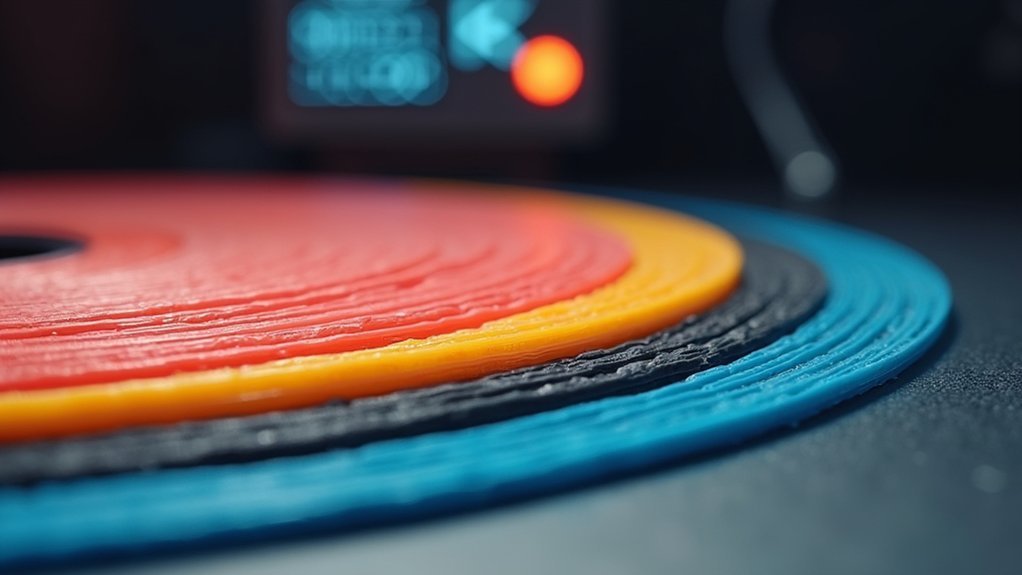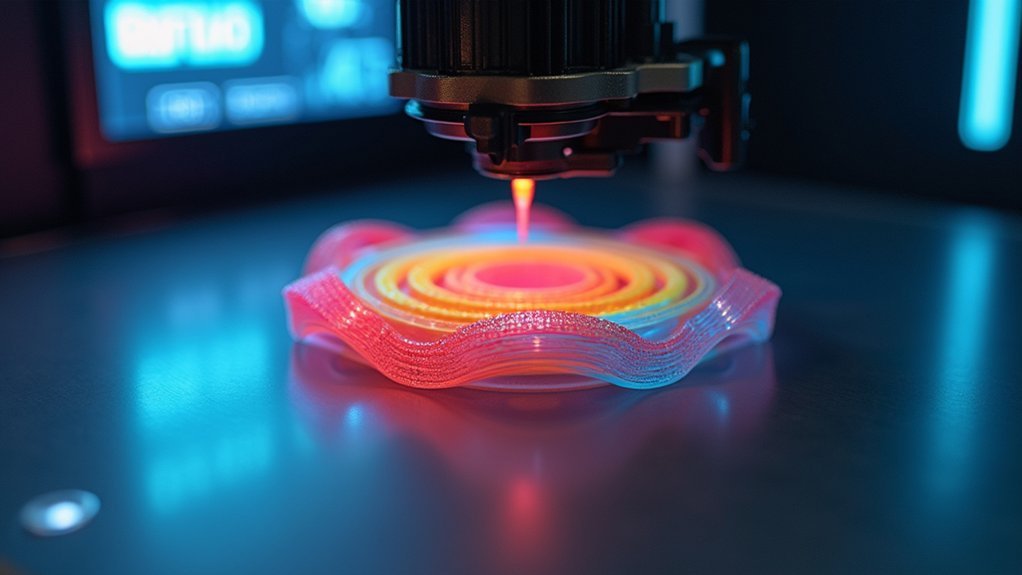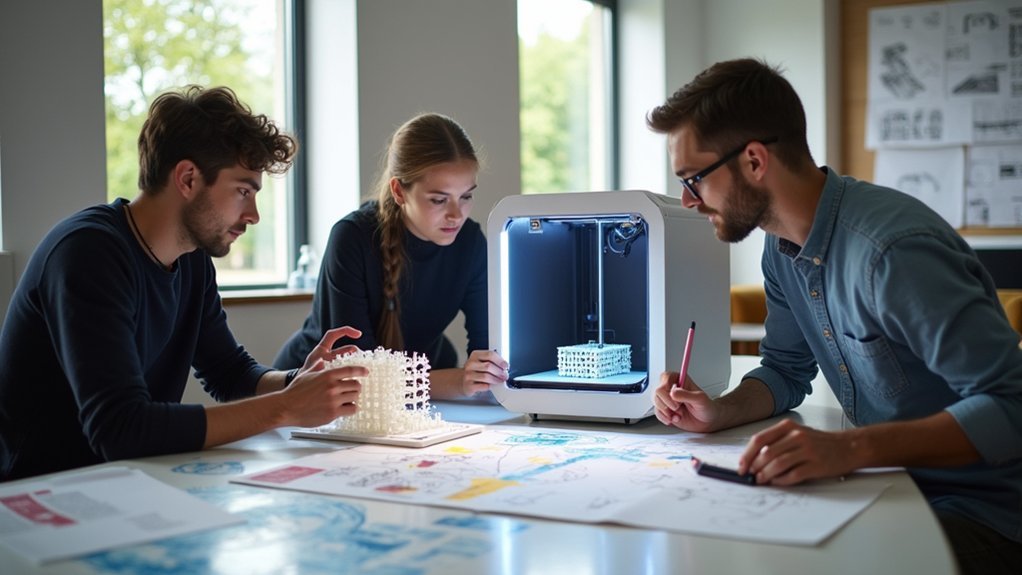Linear Advance settings dramatically enhance your 3D printer’s layer quality by decoupling extrusion from axis movements, preventing the under-extrusion during acceleration and over-extrusion during deceleration that creates bulging corners and inconsistent walls. You’ll achieve sharper corners, cleaner seams, and consistent layer thickness by calibrating K-values between 0.1-2.0 for your specific filament. This real-time pressure compensation delivers measurable improvements in dimensional accuracy while maintaining higher print speeds without quality loss, and there’s much more to optimize for perfect results.
Understanding Linear Advance and Pressure Control Fundamentals

Precision in 3D printing hinges on managing filament flow during complex movements, and Linear Advance technology addresses this challenge by decoupling extrusion from your printer’s axis movements.
This pressure advance system prevents common quality issues by anticipating pressure changes in your hotend’s melt chamber.
When your printer accelerates, filament pressure lags behind the movement, causing under-extrusion and weak layer adhesion. During deceleration, excess pressure creates over-extrusion and bleeding edges.
Linear Advance counters these effects by adjusting extrusion timing based on acceleration and deceleration patterns.
You’ll notice improved dimensional accuracy, cleaner corners, and more consistent layer quality.
The technology works by calculating pressure compensation in real-time, ensuring your filament flow matches intended extrusion rates regardless of speed changes throughout each layer.
Key Improvements and Changes in Version 1.5
Linear Advance Version 1.5 revolutionizes pressure control through a redefined K value system that measures filament compression in [mm of filament compression per 1mm/s extrusion speed]. You’ll experience dramatically improved dimensional precision at higher print speeds without sacrificing quality.
The updated K calibration procedure requires new settings, with PLA values now ranging from 0.1 to 2.0 instead of the previous 30-130 range. You’ll notice smoother extruder operation due to reduced stepper ISR load, minimizing skipped steps during printing.
| Version | K Value Range | Measurement Unit | Benefits |
|---|---|---|---|
| 1.0 | 30-130 | Legacy units | Basic control |
| 1.5 | 0.1-2.0 | mm/mm/s | Enhanced precision |
| 1.5 | Variable | mm/mm/s | Speed flexibility |
Version 1.5 introduces rigorous checks for acceleration, speed limits, and jerk limits, delivering enhanced layer quality and consistency throughout your prints.
Calibrating K-Values for Optimal Extrusion Performance

You’ll need to select K-values within the 0.1 to 2.0 range, which represents a significant shift from earlier PLA values of 30-130 in previous versions.
Focus your calibration testing on changes between slow and fast printing speeds to identify the sweet spot where you avoid under-extrusion during acceleration and over-extrusion during deceleration.
Start with multiple test prints using different K-values, then observe how your extruder handles the varying speeds before settling on your best setting.
K-Value Range Selection
When selecting the ideal K-value range for your specific setup, you’ll need to navigate between outdated recommendations and current best practices.
The k-value range has evolved considerably – while earlier firmware versions used values between 30-130, current calibration standards recommend starting between 10-50 for most users. Modern firmware typically calibrates between 0.1 and 2.0 after updates, making those older values obsolete.
You’ll want to take into account your filament type, printing temperature, and extruder characteristics when fine-tuning within this range.
Pay attention to how pressure in the nozzle responds during speed changes, as this affects extrusion timing. Start conservatively and adjust incrementally to avoid lost steps or overwhelming your printer’s processing power while achieving ideal corner precision.
Speed-Based Calibration Testing
Speed-based calibration testing puts your selected K-value range to work through systematic evaluation of extrusion performance during acceleration and deceleration phases.
You’ll focus on rapid shifts between slow and fast print speeds where under- and over-extrusion typically occur. Print large cuboids with varying pressure advance values to observe extrusion consistency across different movement patterns.
Pay close attention to how well your extruder maintains precision during these critical speed changes where pressure control matters most.
After completing your test prints, you can fine-tune the K-factor based on observed results. This refinement process leads to improved layer adhesion while reducing artifacts like stringing and blob formation, ultimately enhancing your overall print quality through optimized linear advance settings.
Firmware Configuration and G-code Implementation
Configuring Linear Advance requires precise firmware modifications and careful G-code implementation to achieve ideal extrusion control.
Precise firmware tuning and proper G-code implementation are essential for achieving optimal Linear Advance extrusion performance.
You’ll need to modify the Configuration_adv.h file in Marlin firmware and reflash your printer. Set `#define LIN_ADVANCE_K 0` initially to disable hard-coded values, allowing you to customize settings per material.
After firmware installation, you can dynamically adjust the K-Factor using M900 commands. This flexibility lets you fine-tune settings for different filaments without reflashing firmware each time.
Key configuration steps include:
- Enable Linear Advance in Configuration_adv.h
- Set initial K-Factor to 0 for customization
- Use M900 commands for real-time adjustments
- Calibrate K values (PLA: 0.1-2.0 for v1.5)
- Align slicer acceleration settings with printer capabilities
Remember that version 1.5 requires recalibration with considerably lower K values than previous versions.
Speed and Acceleration Adjustments for Enhanced Print Quality

You’ll need to fine-tune your speed and acceleration settings to maximize linear advance’s effectiveness in improving layer quality.
Start by reducing your XY jerk values from the default settings—dropping from 10 to 8 can eliminate ghosting artifacts that plague faster PETG prints.
Configure your acceleration limits thoughtfully, as excessive values can overwhelm linear advance’s ability to compensate for pressure variations during directional changes.
Optimal Speed Settings
Three fundamental adjustments to speed and acceleration settings can dramatically improve your print quality when using Linear Advance. The advance feature works by managing nozzle pressure changes during acceleration and deceleration phases, making proper speed calibration crucial.
When implementing Linear Advance, you’ll need to fine-tune several critical parameters:
- Set first layer speed to 70% of normal printing speed for ideal adhesion
- Reduce XY jerk settings from 10 to 8 when increasing speeds by 50% to prevent ghosting
- Lower perimeter/infill overlap from 25% to 15% to maintain layer integrity at higher speeds
- Adjust retraction from 0.8mm to 0.5mm to minimize visible marks and ooze
- Apply recommended M201 acceleration values to prevent skipped steps during rapid movements
These adjustments guarantee consistent nozzle pressure management throughout your prints.
Jerk Value Reduction
Among the speed adjustments that enhance Linear Advance effectiveness, jerk value reduction stands out as one of the most influential modifications you can make.
When you reduce your XY jerk setting from 10 to 8, you’ll greatly mitigate ghosting issues that compromise layer quality. This adjustment allows your printer’s toolhead to make smoother directional changes during extrusion, resulting in sharper and cleaner prints.
The jerk setting controls how quickly your printer can change direction without decelerating first. By lowering this value, you’re giving your extruder more time to respond to pressure changes, which is exactly what Linear Advance needs to function at its best.
You’ll notice improved corner definition and reduced artifacts that typically appear when the toolhead makes sudden movements during printing.
Acceleration Limit Configuration
While jerk settings control directional changes, acceleration limits determine how quickly your printer reaches its target speeds during layer deposition.
Your acceleration limit configuration directly impacts print quality, especially when you’ve increased speeds beyond standard settings. The extruder motor relies on proper acceleration parameters to maintain consistent filament flow without skipping steps.
When you implement careful acceleration adjustments, you’ll notice significant improvements in dimensional accuracy.
Consider these essential acceleration strategies:
- Set M201 commands in G-code to prevent extruder motor step skipping
- Reduce acceleration values when increasing print speeds by 50% for materials like PETG
- Monitor layer consistency during rapid direction changes
- Balance speed increases with proportional acceleration decreases
- Test acceleration settings incrementally to find ideal values
Slicer Compatibility and Profile Optimization
When you’re implementing linear advance settings, your slicer’s compatibility determines how effectively you can control extrusion pressure throughout your prints. Different slicing software requires specific G-code commands to activate linear advance features properly.
| Slicer | G-code Command | Implementation |
|---|---|---|
| Simplify3D | M900 Kxx | Direct K-value adjustment |
| Slic3r/PrusaSlicer | M900 Kxx | Profile-based configuration |
| Cura | M900 Kxx | Custom start G-code |
You’ll need to adjust K-values based on your filament type within your Printer Settings, as different materials require unique calibration strategies. New experimental profiles like Slic3r’s 0.20mm LA EXPERIMENTAL offer advanced configurations but need thorough testing. Ongoing refinement of your slicer settings and linear advance parameters remains essential, since community feedback and user insights greatly enhance print quality while reducing extrusion issues.
Material-Specific Settings and Filament Considerations
Each filament type demands its own K-value range to achieve ideal linear advance performance.
Different filament materials require individualized K-factor calibration to optimize linear advance settings for peak printing performance.
You’ll need to adjust your K-factor based on material characteristics and pressure build behaviors. PLA typically requires K-values between 10-50, while PETG and other materials need different settings due to their unique flow properties and temperature sensitivities.
Material-specific enhancements include:
- Reducing retraction from 0.8mm to 0.4mm for improved seam quality
- Adjusting K-values based on Bowden tube length and pressure lag
- Experimenting with layer heights to find best settings
- Testing different speeds for each filament type
- Considering temperature sensitivity when calibrating values
Remember that longer Bowden tubes require higher K-values to counteract slippage effects.
You’ll achieve the best results by individually tuning each material rather than using universal settings.
Troubleshooting Common Linear Advance Issues
Several common issues can emerge when implementing linear advance, but most stem from incorrect K-factor calibration or incompatible printer settings.
Under-extrusion typically occurs when you’ve set the K-factor too low, requiring adjustment to maintain consistent pressure throughout printing. Conversely, over-extrusion indicates your linear advance settings are too high, creating blobs and excess filament at move endings.
Layer separation represents another critical problem where misconfigured linear advance disrupts adhesion between layers, compromising overall print integrity.
You’ll need to evaluate print quality meticulously after each adjustment since minor changes dramatically impact outcomes.
Don’t hesitate to consult community forums for valuable troubleshooting insights and shared configuration experiences that can accelerate your problem-solving process.
Real-World Performance Results and User Experiences
Beyond identifying and resolving configuration problems, examining actual user experiences reveals the tangible benefits that properly tuned linear advance delivers in production environments.
You’ll discover that real-world testing consistently demonstrates measurable improvements across multiple quality metrics.
Users who’ve optimized their K-values for linear advance report impressive results:
- Print quality enhancement: Sharper corners and reduced visible seams, particularly with PLA filaments
- Speed improvements: Up to 15% reduction in print time without quality loss
- Extrusion consistency: Better material flow control, especially around corners and direction changes
- Layer adhesion: Improved bonding when combined with adjusted retraction settings (0.8mm to 0.4mm)
- Material-specific optimization: Successful PETG printing with reduced ghosting through targeted K-value adjustments
These documented improvements validate linear advance as essential for achieving professional-grade results.
Frequently Asked Questions
What Does Linear Advance Do?
Linear Advance predicts and adjusts your nozzle pressure during printing, preventing under-extrusion and over-extrusion. It decouples extrusion from print head movement, improving your print’s dimensional accuracy and reducing bleeding edges.
How to Make 3D Print Quality Better?
You’ll improve print quality by calibrating extruder steps, leveling your bed properly, adjusting temperature settings, using quality filament, optimizing print speeds, and fine-tuning retraction distances for cleaner layers.
What Is the Difference Between Coasting and Linear Advance in Cura?
Coasting reduces filament extrusion before move endings to prevent oozing, while Linear Advance dynamically adjusts flow based on print head speed for consistent extrusion throughout your entire printing process.
What Is the Difference Between Linear Advance and Pressure Advance?
You’ll find Linear Advance and Pressure Advance are fundamentally the same feature with different names. Linear Advance appears in Marlin firmware, while Pressure Advance is Klipper’s terminology for identical pressure compensation functionality.





Leave a Reply